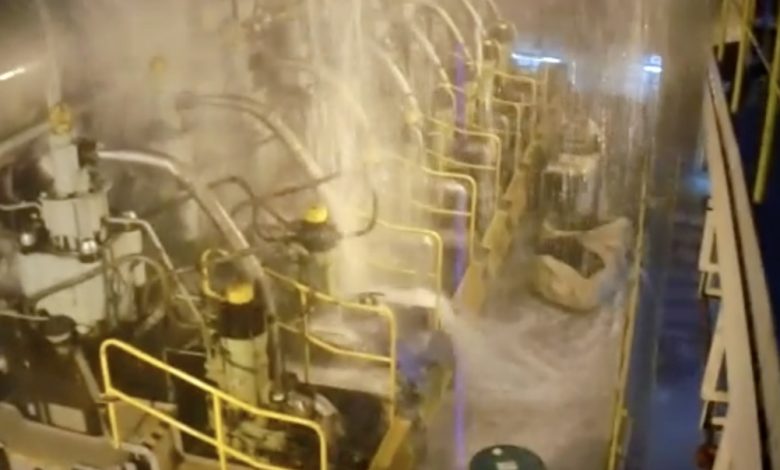Scrubber corrosion cases escalate

Cases of corrosion linked to scrubbers are growing, prompting insurers and authorities to issue advisories.
Norwegian P&I club Gard stated in a note to clients that it has seen a few incidents where within 10-15 months of an open-loop scrubber being installed, corrosion of overboard distance piece or in its immediate vicinity has resulted in water ingress into areas such as the engine room, ballast tanks and cargo holds.
Absence of or poor application of protective coatings on the inside of the pipe and at the welds, along with poor application of paint on hull plating near the washwater discharge were identified as the causes of accelerated corrosion. In all these cases, temporary repairs to plug the leak were carried out by divers followed by permanent repairs at a yard.
The metallic distance piece is normally coated for enhanced protection. There should be a regime to measure the wall thickness, Gard pointed out. Any reduction in thickness is indicative of a breakdown of the coating.
For leakages from welded joints and holes or cracks in the hull, the quality of workmanship and the paint application should be scrutinised, the P&I club urged. Also, the bilge alarm and pumping arrangements should be checked regularly so that the crew is alerted of and can respond to any water ingress.
As a general note, Gard said owners should also consider approaching their scrubber manufacturers and request them to regularly share technical failure related scrubber incidents occurring on ships belonging to other owners.
Singapore’s Maritime and Port Authority (MPA) has also recently issued extensive advice on scrubber maintenance, citing a video carried by Splash of a severe scrubber malfunction that saw thousands of gallons of sea water gush into the engine room of a large bulk carrier (see video below).
“It is imperative that the structural integrity of the scrubber and associated pipework is constantly checked for signs of leakage or corrosion,” MPA stated, adding: “Aside from the video, there are also reports of scrubber corrosion repairs being required less than six months after installation. In view of the acidic nature of the scrubber washwater, correct material selection for the scrubber body, pipework, components and accessories, together with good installation workmanship are critical to avoid subsequent safety issues.”
MPA’s 20-page advisory went on to explain: “The basic operational concept of an SOx wet scrubber involves the mixing of water and sulphur from the exhaust gas. Naturally, this results in a corrosive environment within the scrubber tower and associated pipework. With this, comes the risk of water flooding and escape of exhaust gas into the engine room.”
The MPA advised crews to carry out regular inspection of scrubber tower internal structures and to detect early any signs of pipework leaks. Crew should also ensure that the emergency bilge suction pumps are always in working condition. An additional bilge alarm/flood alarm connected to auto-shutdown of the scrubber and the washwater pumps was also advised by the Singaporean port authority. Manual emergency stops should be placed in the engine control room, on the bridge and on the scrubber panel for manual shut down when required.
As with any new ship technology, operators are experiencing a number of unforeseen teething issues with exhaust gas cleaning systems, not least thanks to corrosion. Splash has counted six scrubber failures in the last month alone.
At last year’s Maritime CEO Forum in Hong Kong, Bjørn Højgaard, CEO of shipmanagement giant Anglo-Eastern, warned that scrubbers are sensitive pieces of equipment sitting in the hostile, hot and acidy environment of a ship’s funnel.
“There are going to be plenty more maintenance issues than people expect,” Højgaard told the exclusive shipowner gathering.
He went on to recount how one car carrier owner he knows had budgeted $10,000 a year in scrubber maintenance per ship. In the first year alone that owner had to spend $100,000 in scrubber maintenance per ship.
These teething problems were cited last month by Euronav, helping explain the Belgian tanker giant’s change of heart on buying into the controversial technology. A massive opponent of scrubbers under previous management, Euronav revealed that it might buy scrubbers next year, giving it “second mover advantage” in learning the flaws of the first round of installations.
Similar to cyber attacks, shipping’s failure to share details on scrubber malfunctions is not helping smooth the introduction of scrubber operations.
“[I]t is important for the industry to share the lessons learned from scrubber related breakdowns to benefit the industry overall,” Gard urged in its advisory to clients this week.

To much in a hurry to install UNTESTED equipment.
Not enough lead time given to investigate materials required.
The materials and the methods were tested over 40 years ago when inert gas scrubbers were developed.
The early ones rotted away very quickly but once everybody realised how corrosive ‘inert’ gas was, things improved.